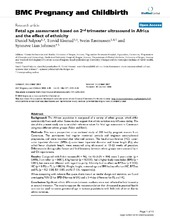Fetal age assessment based on 2nd trimester ultrasound in Africa and the effect of ethnicity
Peer reviewed, Journal article
Published version
Permanent lenke
https://hdl.handle.net/1956/9145Utgivelsesdato
2008-10-30Metadata
Vis full innførselSamlinger
Originalversjon
https://doi.org/10.1186/1471-2393-8-48Sammendrag
Background: The African population is composed of a variety of ethnic groups, which differ considerably from each other. Some studies suggest that ethnic variation may influence dating. The aim of the present study was to establish reference values for fetal age assessment in Cameroon using two different ethnic groups (Fulani and Kirdi). Methods: This was a prospective cross sectional study of 200 healthy pregnant women from Cameroon. The participants had regular menstrual periods and singleton uncomplicated pregnancies, and were recruited after informed consent. The head circumference (HC), outerouter biparietal diameter (BPDoo), outer-inner biparietal diameter and femur length (FL), also called femur diaphysis length, were measured using ultrasound at 12–22 weeks of gestation. Differences in demographic factors and fetal biometry between ethnic groups were assessed by tand Chi-square tests. Results: Compared with Fulani women (N = 96), the Kirdi (N = 104) were 2 years older (p = 0.005), 3 cm taller (p = 0.001), 6 kg heavier (p < 0.0001), had a higher body mass index (BMI) (p = 0.001), but were not different with regard to parity. Ethnicity had no effect on BPDoo (p = 0.82), HC (p = 0.89) or FL (p = 00.24). Weight, height, maternal age and BMI had no effect on HC, BPDoo and FL (p = 0.2–0.58, 0.1–0.83, and 0.17–0.6, respectively). When comparing with relevant European charts based on similar design and statistics, we found overlapping 95% CI for BPD (Norway & UK) and a 0–4 day difference for FL and HC. Conclusion: Significant ethnic differences between mothers were not reflected in fetal biometry at second trimester. The results support the recommendation that ultrasound in practical health care can be used to assess gestational age in various populations with little risk of error due to ethnic variation.
Utgiver
BioMed CentralTidsskrift
BMC Pregnancy and ChildbirthOpphavsrett
Copyright 2008 Salpou et al; licensee BioMed Central LtdDaniel Salpou et al.; licensee BioMed Central Ltd.

